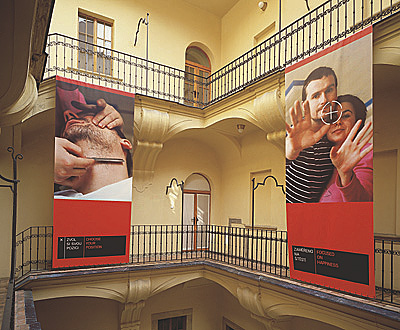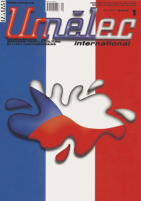| Zeitschrift Umělec 2002/1 >> Incomplete Image of the Backwater | Übersicht aller Ausgaben | ||||||||||||
|
|||||||||||||
Incomplete Image of the BackwaterZeitschrift Umělec 2002/101.01.2002 Jiří Ptáček jr. | biennial | en cs |
|||||||||||||
|
"Zvon, Prague’s biennial of young contemporary Czech artists, is now well established on the Czech arts scene. Failing to do so would have been impossible, as it really has no competition, except perhaps for Youth Salon in Zlín, Moravia; a show which is marginalized due to its distance from the big art cities. Zvon opened its fourth showcase this February, raising expectations only to the extent of wondering who would be represented this time.
Curator Michal Koleček did his best to put together a show of artists he personally considered important, leaning towards artists who are no longer overlooked but who have not been completely absorbed by exhibition and media frenzy. In the end, works by 25 artists (and one group) were compiled, the average age of the artists being about 35. In addition, this year’s Zvon features a new exhibition forum for independent galleries, situated in the basement of the neighboring House of the Golden Ring. Eight of the most active smaller non-profit gallery spaces have been given the opportunity to show that they stand for progress and inspiration to larger commercial spaces, boosting the number of exhibiting artists by a dozen. After only a cursory look at the exhibition, the casual viewer soon discovers that the Czech scene is small — almost everybody is here. And so the biennial comes off as friendly and uncontroversial. The sequencing of works is unassuming and the lack of space is suggested in the leitmotif of proximity, both in the thematic and factual sense of the word. Proximity to fear and insecurity — in spite of the exhibition’s open admission policy. Small works fill the biennial, which may be an accurate and justified reflection of contemporary Czech work, but confining those capable of stretching out has leveled out recognizable differences between works and artists. Also apparent is the flamboyant predilection to fuse artistic language with the social sphere — partly due to the fact that visual art and the populace rarely interface in this country. Social themes in Czech art only became of interest at the latter half of the 1990s and have now reached a point where they are no longer conceived as the only meaning within the works. In fact, there has never been more experimentation and social commentary in Czech art than now, and it has reached a phase where it is no longer passionately applied as the only meaning in the works. We are certain that we are messing around with social phenomenon and we can comment on artistic production from a distance, seeing it as a study and solution. Knowing full well that stoicism has produced cold and pointed commentaries, Michal Koleček has placed the exhibition within this scenario, giving the critics free range. Openness at any price has thus became both a plus and minus, with the positive coming more from the works’ kind relationship to humor — a banal, nicely awkward and absurd humor. Few artists consistently reflected the skepticism in their work that, in terms of interaction with viewers, it’s not going to get any better. Of course we won’t really find an attractive solution in response to the social framework. On the other hand, traditional Czech picturesque quality and the lovely heritage of Josef Lada’s postcard illustrations were also pervasive. Young Czech art, essentially “at the beginning,” thus appears as if it is actually “at the end.” Innovation is lacking and new media and technologies, which contact and interact easier with society, have yet to be embraced. The sole Internet project in the show was recorded onto video for the biennial. But showing artifacts is not the only conservative artistic practice on the local scene. New species of artist fish have recently been planted in the Czech art pond. If they get fed financially, they are liable to reproduce. However, our fishermen curators refuse to alter their nets in any way, and they continue to land the same, albeit tasty, carp. The biennial reflection of our art scene is an image both blurred and crumbling. This show is an autonomous report card on more or less interesting artists, but the overall backwater impression is impossible to ignore. "
01.01.2002
Empfohlene Artikel
|
|||||||||||||








Kommentar
Der Artikel ist bisher nicht kommentiert wordenNeuen Kommentar einfügen